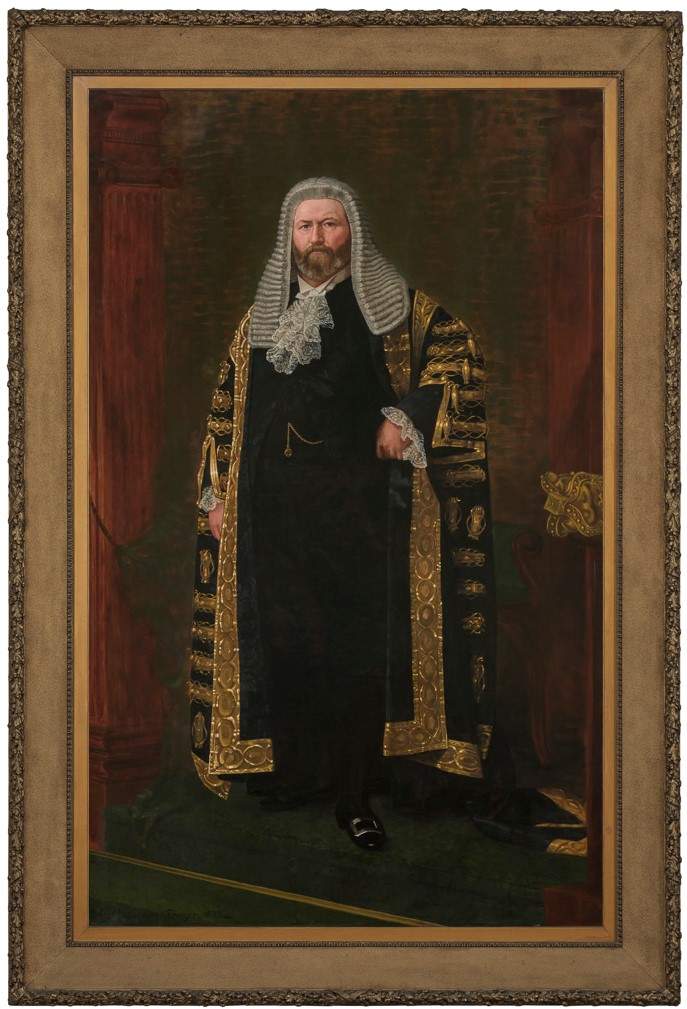Spotlight on the collection: Sir Thomas Bent
In this series we are going to explore some of the interesting items from Bayside City Council’s Art and Heritage Collection. This week we are looking at the very large and imposing portrait painting of Sir Thomas Bent which resides in the foyer of the Brighton Town Hall.

Image credit: Charles E. Gordon Frazer, Sir Thomas Bent 1892, oil on canvas, 190.5 x 146 cm. Bayside City Council Art and Heritage Collection. Commissioned 1892
Sir Thomas Bent
When Thomas Bent, politician and land speculator, was appointed Speaker of the Victorian Legislative Assembly in 1892, a number of local Brighton constituents and supporters raised money to present him with an oil portrait. Bent had been a member for Brighton for 21 years, and the painting was seen as a way of showing their appreciation of his services to the Brighton constituency, as well as congratulating him to his new position as Speaker.
In June 1892, British/Australian landscape and portrait artist Charles E. Gordon-Frazer was given the commission to paint the portrait. Thomas Bent is depicted as standing in his Speaker's robe on the dais beneath the canopy in the Legislative Assembly Chamber in the act of addressing the House. He wears the traditional Speaker’s dress of a black silk and gold laced robe over a three-piece black suit, lace jabot and cuffs, buckled shoes and a long wig.
At its completion, the portrait was commended for its likeness, and in particular for maintaining the predominance of portraiture rather than an emphasis on the accessories. However the hands of the sitter were noted for their unformed appearance, which was not in accordance with the other details of the painting[1]. The portrait has an authoritarian and imposing presence, and is today displayed in the foyer of Brighton Town Hall. Clad in his resplendent robes, Bent sternly stares down at the viewer, his left hand on his hip (a pose which typically appears in portraits of rulers), giving an air of power and self-possession.
This portrait forms part of the colourful and notorious story of Thomas Bent that resonates through the history of the City of Bayside and Victoria. Bent was born in 1838 near Penrith, New South Wales. In 1849, his family relocated to the Port Phillip District and, after a short period in Fitzroy, moved to what is now East Bentleigh to set up a market garden. At the age of 13, Bent left school to help his father on the land and by 21, the enterprising young man had set up his own market garden in McKinnon. In 1861 he became a rate collector for the Brighton Council and not long after that he began buying and selling land in Brighton and Moorabbin, eventually developing the suburb of Bentleigh (named in his honour).
He was Member of the Legislative Assembly for Brighton for 32 years and a Councillor of both Brighton and Moorabbin for 45 years, becoming Mayor of Brighton on nine occasions. Never far from controversy, Bent was an avid land speculator during Melbourne’s boom years and was often accused of neatly overlapping his public role with private interests. For example, as Minister for Railways, he bought up land in Brighton and then approved a tramline that would lead right past his properties.
Throughout this extraordinary career, Bent had an exceptional capacity for work, including tenures as Minister for Railways, Vice-President of the Board of Land and Works, Speaker of the Legislative Assembly (1892-94) and Treasurer and Premier of Victoria (1904-09). In 1908 he was awarded a Knight Commander of the Order of St Michael and St George (KCMG) and when he passed away in 1909 he was given a state funeral which was reportedly attended by 25,000 onlookers. With funds raised through public donations, a statue in Bent’s honour was completed by local artist Margaret Baskerville and was erected in the centre of the Nepean Highway in 1913.
The artist Charles E. Gordon-Frazer studied at St John's School of Art, South Kensington before attending the Royal Academy School in London. In June 1885, he set about to become a topographical painter, embarking for New Zealand and travelling extensively around Australasia, Vanuatu and New Guinea for the next two years. He was the first European artist to enter the wilderness of the Tanna Island in Vanuatu and according to scholars was the only white man ever to witness (and survive) a cannibal ceremony there. He soon settled in Melbourne in the early 1890s where he shared a studio with John Mather at the Austral Chambers in Collins Street. Here he completed a number of paintings from his travels and took on a several portrait commissions including the large portrait of Sir Thomas Bent. Following his stay in Australia, he left for South America. His final journey was to Thailand where he was to complete portraits of the Royal family, however he contracted backwater fever and died in 1899 at the age of 36. His works are represented in the National Gallery of Victoria, the National Gallery of Australia and the City of Yarra Collection.
_____________________________________________
[1] ‘Accidents will happen’, Melbourne Punch (Vic. : 1855 - 1900), Thursday 25 August 1892, p. 14
Interested in learning more about the Art and Heritage Collection?
Bayside City Council is the custodian of the Bayside Art and Heritage Collection, a collection of around 2,000 items that was principally formed when the former Sandringham and Brighton City Councils merged in 1994. Artworks and heritage objects are displayed at our Corporate Centre in Sandringham, Bayside Gallery in Brighton and other Council owned buildings.